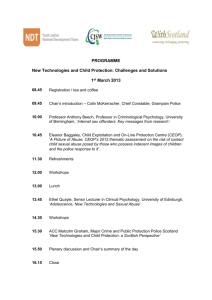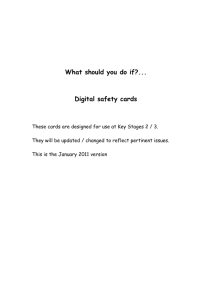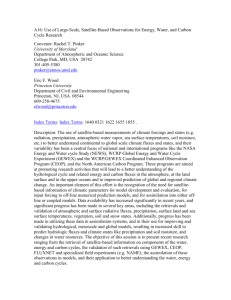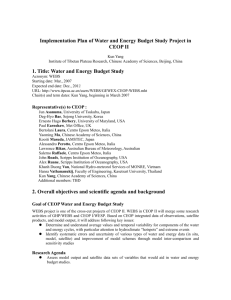NOTES FROM THE SIXTH FORMAL COORDINATED ENERGY AND WATER-CYCLE OBSERVATIONS
advertisement
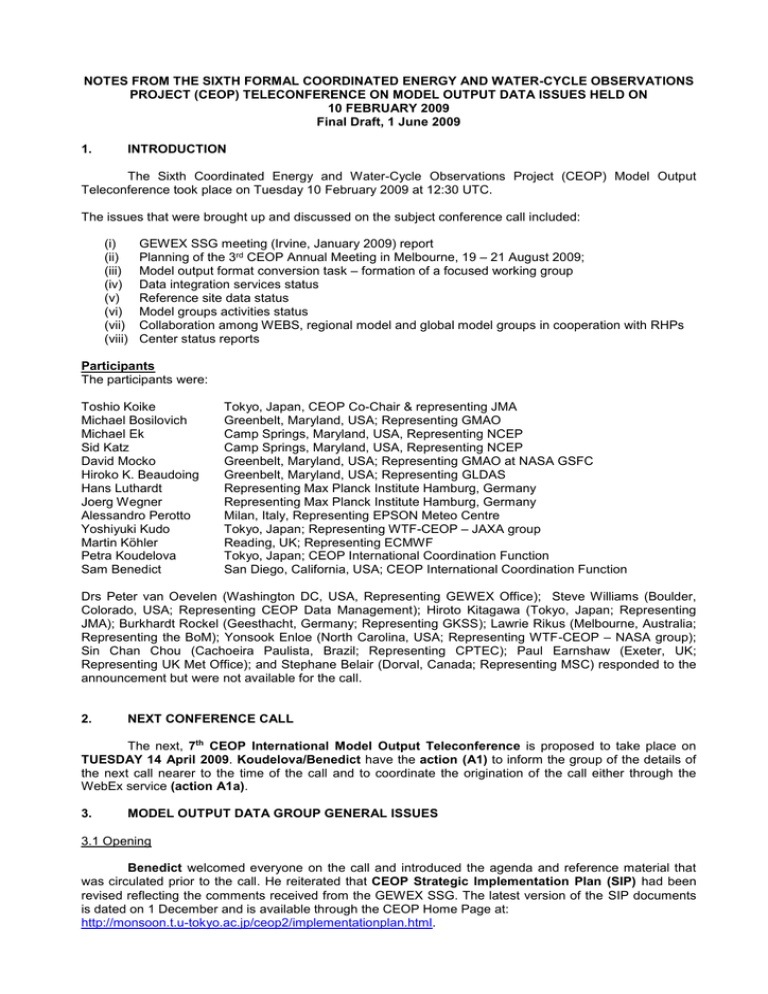
NOTES FROM THE SIXTH FORMAL COORDINATED ENERGY AND WATER-CYCLE OBSERVATIONS PROJECT (CEOP) TELECONFERENCE ON MODEL OUTPUT DATA ISSUES HELD ON 10 FEBRUARY 2009 Final Draft, 1 June 2009 1. INTRODUCTION The Sixth Coordinated Energy and Water-Cycle Observations Project (CEOP) Model Output Teleconference took place on Tuesday 10 February 2009 at 12:30 UTC. The issues that were brought up and discussed on the subject conference call included: (i) (ii) (iii) (iv) (v) (vi) (vii) (viii) GEWEX SSG meeting (Irvine, January 2009) report Planning of the 3rd CEOP Annual Meeting in Melbourne, 19 – 21 August 2009; Model output format conversion task – formation of a focused working group Data integration services status Reference site data status Model groups activities status Collaboration among WEBS, regional model and global model groups in cooperation with RHPs Center status reports Participants The participants were: Toshio Koike Michael Bosilovich Michael Ek Sid Katz David Mocko Hiroko K. Beaudoing Hans Luthardt Joerg Wegner Alessandro Perotto Yoshiyuki Kudo Martin Köhler Petra Koudelova Sam Benedict Tokyo, Japan, CEOP Co-Chair & representing JMA Greenbelt, Maryland, USA; Representing GMAO Camp Springs, Maryland, USA, Representing NCEP Camp Springs, Maryland, USA, Representing NCEP Greenbelt, Maryland, USA; Representing GMAO at NASA GSFC Greenbelt, Maryland, USA; Representing GLDAS Representing Max Planck Institute Hamburg, Germany Representing Max Planck Institute Hamburg, Germany Milan, Italy, Representing EPSON Meteo Centre Tokyo, Japan; Representing WTF-CEOP – JAXA group Reading, UK; Representing ECMWF Tokyo, Japan; CEOP International Coordination Function San Diego, California, USA; CEOP International Coordination Function Drs Peter van Oevelen (Washington DC, USA, Representing GEWEX Office); Steve Williams (Boulder, Colorado, USA; Representing CEOP Data Management); Hiroto Kitagawa (Tokyo, Japan; Representing JMA); Burkhardt Rockel (Geesthacht, Germany; Representing GKSS); Lawrie Rikus (Melbourne, Australia; Representing the BoM); Yonsook Enloe (North Carolina, USA; Representing WTF-CEOP – NASA group); Sin Chan Chou (Cachoeira Paulista, Brazil; Representing CPTEC); Paul Earnshaw (Exeter, UK; Representing UK Met Office); and Stephane Belair (Dorval, Canada; Representing MSC) responded to the announcement but were not available for the call. 2. NEXT CONFERENCE CALL The next, 7th CEOP International Model Output Teleconference is proposed to take place on TUESDAY 14 April 2009. Koudelova/Benedict have the action (A1) to inform the group of the details of the next call nearer to the time of the call and to coordinate the origination of the call either through the WebEx service (action A1a). 3. MODEL OUTPUT DATA GROUP GENERAL ISSUES 3.1 Opening Benedict welcomed everyone on the call and introduced the agenda and reference material that was circulated prior to the call. He reiterated that CEOP Strategic Implementation Plan (SIP) had been revised reflecting the comments received from the GEWEX SSG. The latest version of the SIP documents is dated on 1 December and is available through the CEOP Home Page at: http://monsoon.t.u-tokyo.ac.jp/ceop2/implementationplan.html. 3.2 GEWEX Legacy Document and the SSG meeting outcomes (3.2a) Benedict advised the group that CEOP had submitted its contribution to the WCRP/GEWEX Legacy Document as requested that included (1) CEOP accomplishments and (2) the legacy for future based on what has been done and what is felt to be important to be continued. The document covers all the CEOP components and is based on the material presented at the 2 nd CEOP Annual Meeting and the CEOP element reports that were submitted by end of November 2008. (3.2b) Benedict and Koike further informed the group of the outcomes of the GEWEX SSG meeting that was held in Irvine, USA, January 2009. They referred to the Rapporteurs comment document that was circulated prior to the call and voiced that CEOP was well received, especially the Model analyses and intercomparison studies and also the data component. It was also pointed out that CEOP was a large project with wide scope of activities and it was difficult to provide rather brief overview of its activities that would fit to the SSG meeting format. At such events, CEOP should focus on major topics contributing to the overall objectives of GEWEX and provide broader reports at the CEOP meetings and through annual reports. At this opportunity, Koike and Benedict commended Bosilovich for his excellent input on the Model activities at the SSG meeting that was very well regarded by the SSG members. 3.3 The 3rd CEOP Annual Meeting in Melbourne, Australia, 19 – 21 August 2009 (3.3a) Benedict reiterated that the next, 3rd CEOP Annual Meeting would be held in Melbourne, Australia, 19 – 21 August 2009, i.e. the event would precede the GEWEX and iLEAPS science conferences. Because of the opportunity to present scientific and technical papers at the GEWEX and iLEAPS science conferences, the CEOP meeting itself will be more programmatic oriented and will focus on strategic planning inputs and discussions. Accordingly, participants were recommended to submit their scientific and technical achievement papers to the GEWEX/iLEAPS conferences (see the paragrapth 3.3b below). The venue for the CEOP meeting will be the Bureau of Meteorology (BoM) and Drs. Lawrie Rikus, Helen Cleugh, and Michael Manton have kindly accepted the role to serve as the local organizing committee. Further details and the meeting website will be released in due course. (3.3b) The 6th International Scientific Conference on GEWEX and the 2nd iLEAPS Science Conference will be held in Melbourne, Australia, 24 – 28 August 2009. The conference website is available at: http://www.gewex.org/2009gewex_ileaps_conf.html. Abstracts for all sessions can be submitted on-line through the meeting website. The final extended deadline for abstract submission is 15 April 2009. As a part of the GEWEX conference, a special poster session on High Elevations is being organized by the CEOP High Elevation group. The due date for abstract submission to this session is also 15 April 2009. More information is available through the High Elevation element website at: http://www.ceop-he.org/cms/. 3.4 CEOP Special Issue Koike advised the group that a second CEOP Special Issue of a peer reviewed scientific journal was being planned by the CEOP Co-Chairs. Further details and call for papers will be announced in spring 2009. The due date for paper submissions is considered in spring 2010. In addition, CEOP Co-Chairs, Drs. Koike and Stewart, are preparing an article on CEOP for BAMS. 3.5 CEOP Global Model Study (http://gmao.gsfc.nasa.gov/research/modeling/validation/ceop.php) (3.5a) Bosilovich reported GMAO and ERA interim reanalysis data had been added to the MAC ensembles and the new version of the dataset would be soon added on their ftp site (ftp://agdisc.gsfc.nasa.gov/private/ceop/). They have been reviewing a manuscript on this study and expected the acceptance of this paper in the near future. Also, further results of this study could be considered for the proposed CEOP Special Issue #2. (3.5b) Bosilovich also voiced that the results using CEOP Phase 1 data were very encouraging and thus the effort should continue with the data currently being collected. The center representatives were asked to consider their participation in this continued activity. 3.6 JAXA CEOS/WGISS Test Facilities (WTF) for CEOP (3.6a) Kudo reported that the system hardware had been replaced and since 29 January it was back in full operation and running smoothly at the former URL: http://ceop.restec.or.jp/. (3.6b) Kudo further pointed out that no new data or functionality was being added to the system due to budget limitations for this fiscal year. He explained that in order to include further data on the system a certain steps had to be undertaken by the system administrators that were beyond the current budget. It means that even though new data is submitted to the MPI (model output) and NCAR (reference site observations), these will not be accessible through the JAXA system until specific menus and links are added to the system. In this context Koike voiced that he would negotiate with the JAXA management to improve the budget situation to allow for further development of the JAXA Distributed Data Integration System (action A2). (3.6c) Regarding the possible demonstration of the system, Katz reiterated that certain discrepancies had been found between the NCEP forecast MOLTS data submitted to the MPI archive and those available on the system. Reflecting on the JAXA/RESTEC team budget issues, it was proposed and accepted that the demonstration of the system is postponed until the NCEP data on the JAXA system can be corrected and further data added. (3.6d) - Kudo further reiterated the brief statistic summary on the system use: currently 138 users registered 20 users accessed the system in October the required data mostly included satellite and MOLTS data 3.7 CEOP Model Output format issues and MPI status (3.7a) Luthardt reported that their team continued the work on CEOP Phase 1 data homogenization and converting into the NetCDF format. In addition, the ERA Interim Reanalysis data has been successfully downloaded from the ECMWF site. (3.7b) Regarding the MOLTS data format it was reiterated that a small working group would be formed consisting of suitable representative(s) from each participating center that would focus on this task. Based on the participants interest expressed at the time of the previous call, a preliminary list of members of such dedicated working group has been drafted that was circulated before the call. The list has been subsequently updated based on further communication with respective center representatives (see Attachment 1). To communicate specific issues, this working group would organize small, dedicated calls when necessary. Koudelova and Benedict have continued action A3 to coordinate initiation of the group activities through a kick-off conference call. It was proposed and accepted that the first task the group focuses on will be the MOLTS format conversion subroutine provided by JMA and its possible utilization by other centers. The subroutine with English commentary was circulated within the group prior to the call and then subsequently once again. If anybody has missed these documents, please contact Koudelova and Benedict. (3.7c) In addition, the question of the most suitable gridded output format was raised during the call. Luthardt explained that the MPI suggested splitting the GRIB files into a set of files so that each file contain only one model output variable. This suggestion is based on user experiences and it would be desirable if the centers could provide the gridded output in such format. It was mentioned that JMA was providing their output in this format and thus it was proposed that other centers follow the JMA’s approach. Koike undertake action A4 to discuss with JMA the possibility to also provide the GRIB file splitting subroutine to other centers. The Data Format group will also include the task of the gridded output format on its near future agenda. (3.7d) Luthardt further voiced that it would be highly desirable to update model output documentation and ask the center representatives for their kind cooperation on this matter. In this context, Benedict reiterated that a formal request to the NWP centers had been drafted and sent to update their model system and output documentation (see Attachment 2) but there had been only few responses to this request. Accordingly, the center representatives were asked to complete this task as soon as practical (action A5). Also on this matter, Koike advised the group that under the DIAS project of Japan, data provider support tools were being developed to facilitate generation of unified format documentation on various data. These tools will be available through internet in the near future. 3.8 Reference site data (3.8a) On behalf of Williams, Benedict reported that three series of conference calls had been initiated that focused on Regional Hydroclimate Projects and reference site data. The calls are organized separately for three regions of the world, namely (i) Americas, (ii) Europe, NEESPI and Africa, and (iii) Asia-PacificAustralia. As it was expected, the calls have reactivated the reference site data submission and new data have been already received at the NCAR archive. The updates can be reviewed and available data downloaded through the Data Management website at: http://data.eol.ucar.edu/master_list/?project=CEOP/EOP-3/4. 3.9 Collaboration among WEBS, regional model and global model groups in cooperation with RHPs (3.9a) Koike advised the participants that the WEBS group chaired by Dr. Kun Yang had been preparing a high-resolution forcing dataset for the area of China, i.e. including the Tibetan Plateau, for the years 1998 - 2007. In addition to the forcing dataset, the group plans to produce soil moisture and surface fluxes datasets through assimilation of the AMSR-E data. These datasets may be very useful for validation of regional models as well as global model output and thus cooperation between WEBS, global (MAC) and regional (ICTS) model groups was proposed. Koike further mentioned that Dr. Yang would visit the University of Tokyo during next month and this opportunity could be used to organize a small conference call among the leaders of the modeling groups and WEBS to discuss further details of possible cooperation. (3.9b) Subsequently, such a call took place on 27 February 2009 and included following participants: T. Koike, M. Bosilovich (Global models and MAC), D. Mocko (MAC), K. Yang (WEBS), B. Rockel (ICTS), S. Benedict, and P. Koudelova. Yang introduced the intended datasets and the production timeline according which the complete datasets should be available by the end of 2009. Nevertheless, he agreed to try to provide partial results/sample of data and documentation to the MAC and ICTS groups by July/August 2009 so that these groups can begin to design the validation studies. (3.9c) It was further proposed and agreed that such cooperation should be expanded to other RHPs regions through closer cooperation with RHPs (complex datasets provision) and following the pilot study in Tibet. Considering the CEOP dataset completeness, it was decided to focus on 2003 – 2004 period. The model group and WEBS leaders including Bosilovich, Mocko, Rockel, and Yang were asked to discuss and outline a strategic plan for the proposed validation studies (action A6) that could be introduced to the RHP representatives in the near future. 4. CURRENT STATUS OF NWPCs 4.1 GLDAS by Hiroko Kato (4.1a) Kato reiterated that the work on the Phase 2 contribution was progressing but they had not submitted any data to the MPI database yet. Efforts are being made to adjust the output subroutines so that the MOLTS data is in the agreed to NetCDF format. Similarly, their team is willing to prepare the gridded output in the suggested format and would welcome the said JMA subroutine for the gridded output. (4.1b) Kato further mentioned that they were evaluating long-term simulations with focus on the effect of global forcing instability. The group plans to use a new, more stable forcing dataset and also to perform simulations with a new land model that includes groundwater system. 4.2 BoM by Lawrie Rikus Rikus reported in writing that the gridded data scripts were complete but the results needed to be checked for possible errors. The MOLTS data will be added in at the same time and the production mode should begin soon. 4.3 GMAO by Mike Bosilovich Bosilovich reiterated that the GMAO CEOP data had been generated and would be uploaded to the MPI archive in the near future. Firstly, the global output would be sent followed by the MOLTS data. Bosilovich mentioned that they could prepare the gridded output as requested by MPI and emphasized the importance of the unified format across the data providers for making the data useful for advanced studies as MAC. 4.4 NCEP by Sid Katz Katz reported that they had finalized the MOLTS format for new CEOP phase including all 178 MOLTS points and they would begin to submit the data for the period from 1 June 2008 up to current and then backfill the data from 1 January through 31 May 2008 in this new format. The 2007 data will be most probably submitted in the same format as the data for CEOP Phase 1 (i.e. 41 MOLTS points of Phase 1). 4.5 EMC by Alessandro Perotto (4.5a) Perotto reiterated that they had found certain issue in their model system and the results were not satisfactory. Accordingly, their team considered model system upgrade before generating the data for CEOP. In addition, the EMC hardware facilities have also been replaced, which contributes to the delay in data production. (4.5b) Subsequently after the call, Perotto advised the group in writing of the further details. After several months of testing and intercomparison they have decided to run parallel to the “classic” EMC global model the global WRF-ARW model (in the latest versions of WRF also global runs are supported). Gradually within a few months several operative global forecasts made with the EMC model will be stopped and substituted by global WRF. Reflecting on these developments, the EMC team has decided to provide the data from global WRF model to CEOP. While WRF-ARW is a model not developed by EMC, but by NCAR, publicly there is still very little data and few results for global WRF. Thus the EMC team believes that the use of this model results in CEOP would be desirable and could also arise the interest of the very wide WRF community. Moreover, WRF is one of very few global gridded models, making it unique compared to the other global models used in the new phase of CEOP. 4.6 ECMWF by Martin Köhler Köhler expressed his appreciation of the Interim reanalysis data being used in the MAC ensembles and reported that the reanalysis was reaching September 2008 and thus 2007-2008 data would be provided to MPI in the near future. The format of these data will be the same as the format of the 2003-2004 data submitted earlier. 4.7 CPTEC by Sin Chan Chou – in writing Subsequently after the call, Chou has advised the CEOP Coordination Function that Dr. Dirceu Herdies would substitute her as CPTEC representative on the CEOP Model Output group. Dr. Herdies (dirceu.herdies@cptec.inpe.br) is the head of the Modeling and Development Division at CPTEC and is responsible for data assimilation. Dr Herdies will also join the Model Output Format working group and will participate in the next conference call. 5. OTHER ISSUES 5.1 Meetings (5.1a) The next 3rd CEOP Annual Meeting will be held in Melbourne, Australia, from 19 through 21 August 2009 in conjunction with the GEWEX/iLEAPS science conferences that will take place in Melbourne, 24 – 28 August 2009 (http://www.gewex.org/2009gewex_ileaps_conf.html). Further details of the CEOP meeting will be provided in due course. (5.1b) The 2nd Lund Regional-scale Climate Modeling Workshop will be held in Lund, Sweden from 4 – 8 May 2009 (see the GEWEX calendar page for more information). (5.1c) The International Conference "Mountains: energy, water and food for life. The SHARE project: understanding the impacts of climate change" will be held in Milan, Italy, from 27 – 28 May 2009 (see the CEOP website for further information: http://monsoon.t.u-tokyo.ac.jp/ceop2/meetings.html). (5.1d) The 3rd International AMMA Conference will be held in Ouagadougou, Burkina Faso, from 20 – 24 July 2009 (conference webpage: http://www.amma-international.org/rubrique.php3?id_rubrique=1). (5.1e) The 6th International Scientific Conference on GEWEX and the 2nd iLEAPS Science Conference will be held in Melbourne, Australia, 24 – 28 August 2009. The conference website is available at: http://www.gewex.org/2009gewex_ileaps_conf.html. Abstracts for all sessions can be submitted on-line through the meeting website. The final extended deadline for abstract submission is 15 April 2009. 6. CLOSING Koike acknowledged the participants for attending the call and providing their valuable contributions, comments and suggestions. The call was adjourned at 14:30 UTC. ATTACHMENT 1: List of members of the CEOP Model Output Working Group on Data Format Issues 1. 3. 4. 5. 6. 7. 8. 9. 10. 11. 12. 13. 14. 15. 16. 17. Sid Katz (NCEP) Hiroto Kitagawa (JMA) Hiroko Kato Beaudoing (GLDAS) Beate Geyer (GKSS – ICTS) Mike Bosilovich (GMAO) Martin Köhler (ECMWF) Alessandro Perotto (EMC) Frank Toussaint (MPI) Joerg Wegner (MPI) Lawrie Rikus (BoM) Paul Earnshaw (UKMO) Dirceu Herdies (CPTEC) Stephane Belair or someone from MSC? Someone from NCMRWF? Toshio Koike (CEOP Co-Chair) Sam Benedict (CEOP International Coordinator) ATTACHMENT 2: Request for updating the model data documentation Dear Modeling Center Colleagues, Our recent CEOP Model Output International Conference call highlighted the need for making the documentation available through our CEOP Data Management Web site current and especially consistent with the data that has been sent to the CEOP Model Output Archive Center at the Max Planck Institute in Hamburg Germany. An action to all Center representatives was recommended whereby they would be asked to update the documentation as soon as possible. This action is made necessary by the fact that users of the data have begun to work with the data to provide new and important results that are attributable to the work and effort the CEOP Contributing Centers have put in to produce the data and send it to the MPIM Center at Hamburg. Without current up to date documentation the ability for these results to be applied most effectively may be lessoned. Only through your kind attention to the request as outlined below can we ensure that our work will be widely acknowledged and most efficiently applied: Thank you for providing model output/data and information to support CEOP. The model documentation from each Center was previously collected and is located on a master table located directly at: http://www.eol.ucar.edu/projects/ceop/dm/model/model_table.html The purpose of this table is to summarize and compare model characteristics and to provide access to specific documents/links that support researchers using the model output. By "clicking" on the individual Center (in the first column of the Table) it will provide additional specific detailed documentation. It has been several years since much of this information and documentation has been updated. Thus, we would like you to review the information from your respective model. Specifically, 1. Please review and verify the model characteristics in the Table columns for your respective model. Provide any changes, links, or missing information. 2. Please review the detailed documentation for your respective model (http://www.eol.ucar.edu/projects/ceop/dm/model/model_chars.html) and provide any updated or additional documentation, technical reports, references, links, or other pertinent information. 3. If one exists, please provide a key reference or document that best describes the system and process used to produce the CEOP model output contributed to MPI. It is also very useful to describe what changes have been applied to the model during the period of CEOP. We will highlight this document in the table, so that it is clear where users can go for specific details regarding the model, assimilation, characteristics, and other supporting information. Some of the Modeling Centers have provided such documents in the past and they proved to be very helpful to the user in interpreting the model output. 4. Even if all the model documentation and information is the latest version and correct, please verify this through a reply e-mail. Please send any updates, changes, new information, or verification to Steve Williams (sfw@ucar.edu) and Scot Loehrer (loehrer@ucar.edu) so that changes to the web pages can be made. Thank you very much for your assistance and feel free to contact Steve and Scot should you have any questions. Regards, Toshio Koike, CEOP Co-Chair

